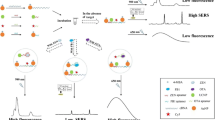Abstract
By taking advantage of the intrinsic fluorescence of ochratoxin A (OTA), we present a fluorescence anisotropy approach for rapid analysis of the interactions between OTA and aptamers. The specific binding of OTA with a 36-mer aptamer can induce increased fluorescence anisotropy (FA) of OTA as the result of the freedom restriction of OTA and the increase of molecular volume, and the maximum FA change is about 0.160. This FA approach enables an easy way to investigate the effects of buffer compositions like metal ions on the affinity binding. FA analysis shows the interaction between OTA and aptamer is greatly enhanced by the simultaneous presence of Ca2+ and Na+, while the binding affinity of aptamer decreases more than 18-fold when only Ca2+ exists, and the binding is completely lost when Ca2+ is absent. Crucial region of the aptamer for binding can be mapped through FA analysis and aptamer mutation. The demonstrated FA approach maintains the advantages of FA in simplicity, rapidity, and robustness. This investigation will help the development of aptamer-based assays for OTA detection in optimizing the binding conditions, modification of aptamers, and rational design.

The free ochratoxin A (OTA) molecule tumbles rapidly and shows low fluorescence anisotropy (FA), while the bound OTA by the aptamer has increased molecular volume and restricted freedom, showing enhanced FA. FA analysis allows screening the interaction between OTA and aptamer





Similar content being viewed by others
References
Monaci L, Palmisano F (2004) Anal Bioanal Chem 378:96–103
Hayat A, Paniel N, Rhouati A, Marty JL, Barthelmebs L (2012) Food Control 26:401–415
McGown LB, Joseph MJ, Pitner JB, Vonk GP, Linn CP (1995) Anal Chem 67:663A–668A
Liu J, Cao Z, Lu Y (2009) Chem Rev 109:1948–1998
Klussmann S (ed) (2006) The aptamer handbook, functional oligonucleotides and their applications. Wiley, Weinheim
Li Y, Lu Y (2009) Functional nucleic acids for analytical applications. Springer, New York
Cruz-Aguado JA, Penner G (2008) J Agric Food Chem 56:10456–10461
Cruz-Aguado JA, Penner G (2008) Anal Chem 80:8853–8855
Kuang H, Chen W, Xu D, Xu L, Zhu Y, Liu L, Chu H, Peng C, Xu C, Zhu S (2010) Biosens Bioelectron 76:710–716
Girolamo AD, McKeague M, Miller JD, DeRosa MC, Visconti A (2011) Food Chem 127:1378–1384
Chapuis-Hugon F, du Boisbaudry A, Madru B, Pichon V (2011) Anal Bioanal Chem 400:1199–1207
Yang C, Lates V, Prieto-Simón B, Marty JL, Yang X (2012) Biosens Bioelectron 32:208–212
Gradinaru CC, Marushchak DO, Samim M, Krull UJ (2010) Analyst 135:452–459
Jameson DM, Ross JA (2010) Chem Rev 110:2685–2708
Lea WA, Simeonov A (2011) Expert Opin Drug Discov 6:17–32
Smith DS, Eremin SA (2008) Anal Bioanal Chem 391:1499–1507
Wang H, Lu M, Tang MS, Van Houten B, Ross JBA, Weinfeld M, Le XC (2009) Proc Natl Acad Sci U S A 106:12849–12854
Zhang DP, Lu ML, Wang H (2011) J Am Chem Soc 133:9188–9191
Zhang DP, Zhao Q, Zhao BL, Wang H (2012) Anal Chem 84:3070–3074
Ruta J, Perrier S, Ravelet C, Fize J, Peyrin E (2009) Anal Chem 81:7468–7473
Perrier S, Ravelet C, Guieu V, Fizea J, Roy B, Perigaud C, Peyrin E (2011) Biosens Bioelectron 25:1652–1657
Kidd A, Guieu V, Perrier S, Ravelet C, Peyrin E (2011) Anal Bioanal Chem 401:3229–3234
Wang Y, Killian J, Hamasaki K, Rando RR (1996) Biochemistry 35:12338–12346
Kwon M, Chun SM, Jeong S, Yu J (2011) Mol Cells 11:303–311
Jing M, Bowser MT (2011) Anal Chim Acta 686:9–18
Wei AP, Herron JN (1993) Anal Chem 65:3372–3377
Deng Q, German I, Buchanan D, Kennedy RT (2001) Anal Chem 73:5415–5421
Sines CC, McFail-Isom L, Howerton SB, VanDerveer D, Williams LD (2000) J Am Chem Soc 122:11048–11056
Owczarzy R, Moreira BG, You Y, Behlke MA, Walder JA (2008) Biochemistry 47:5336–5353
Acknowledgments
This work was supported by the grants from National Natural Science Foundation of China (grant no. 20905043), the Research Project Supported by Shanxi Scholarship Council of China, the State Key Laboratory of Environmental Chemistry and Ecotoxicology in the Research Center for Eco-Environmental Sciences of the Chinese Academy of Sciences (grant no. KF2010-24), and the Key Project of Chinese Ministry of Education (grant no. 212020).
Author information
Authors and Affiliations
Corresponding author
Additional information
ABC Highlights: authored by Rising Stars and Top Experts.
Electronic supplementary material
Below is the link to the electronic supplementary material.
ESM 1
(PDF 446 KB)
Rights and permissions
About this article
Cite this article
Geng, X., Zhang, D., Wang, H. et al. Screening interaction between ochratoxin A and aptamers by fluorescence anisotropy approach. Anal Bioanal Chem 405, 2443–2449 (2013). https://doi.org/10.1007/s00216-013-6736-1
Received:
Revised:
Accepted:
Published:
Issue Date:
DOI: https://doi.org/10.1007/s00216-013-6736-1




